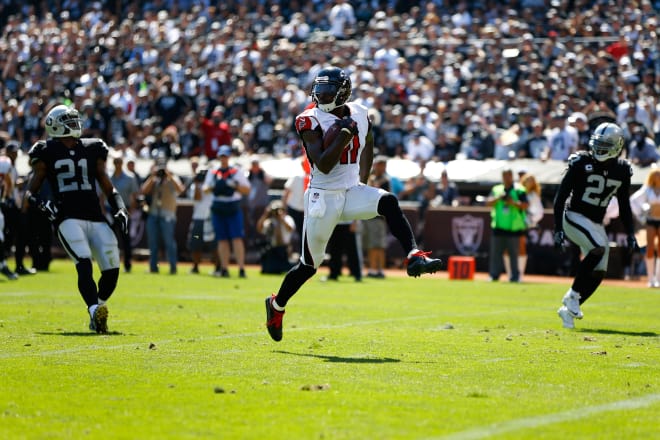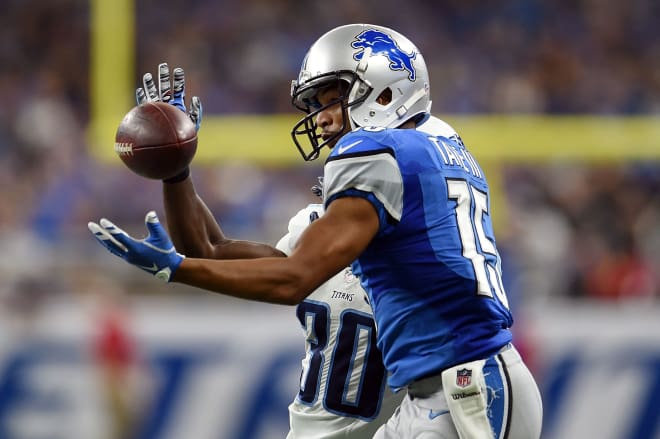Which school deserves to be called Wide Receiver U?
Mark Pszonak contributed to this report.
Now that we’ve determined that FSU is QBU and Alabama is RBU, at least since 2010, based on college and NFL success, it’s time to turn our attention to WRU. Many years ago, the instant answer would be Miami, but times have certainly changed and now this Top 5 is owned by others. Here’s our picks.
The Criteria: Since 2010, we looked at how many first round NFL Draft Picks a college produced, how many wide receivers from a school were top 10 in receiving yards in a college season and how many wide receivers from a school were top 10 in the NFL in receptions. Of course we also included intangibles like Heisman voting, All-Pro selections, Pro Bowls, other awards, the number of top receivers a college produced over this span and pure subjective opinion. Enjoy.
RELATED: Which school is QBU? | RBU
1. ALABAMA

The trio of Julio Jones, Amari Cooper and Calvin Ridley firmly places the Crimson Tide at the top. Both Jones and Cooper were first round draft picks. Ridley is on that same path after an extremely impressive freshman season last fall and expectations of picking it up this season as his freshman quarterback gets more comfortable. Jones dominated SEC defenses and has done the same in the NFL with Atlanta. His career with the Falcons was highlighted by his performance last season, when he led the league in both receptions and receiving yards. Cooper followed up a 2014 season in Alabama when he finished second nationally in receiving yards and receiving touchdowns by finishing third in the NFL Offensive Rookie of the Year voting after grabbing 72 receptions for 1,070 yards and six touchdowns last fall. Ridley has picked up right where Cooper left off, as he finished first in the SEC in receptions and second in receiving yards as a true freshman in 2015.
2. LSU

While Odell Beckham Jr. has become a star in the NFL, it was actually his collegiate teammate Jarvis Landry who mostly outperformed him in Baton Rouge. Despite this, it was Beckham Jr. who was drafted in the first round while Landry went in the second round to Miami. Since their arrival in the NFL, Beckham flourished immediately, while Landry took a season to adjust before also becoming a star in 2015 when he finished fourth in the league with 110 receptions.
For Beckham, he won the Offensive Rookie of the Year in 2014, has already made two Pro Bowls and has finished in the top 10 during his first two seasons in receptions, receiving yards and receiving touchdowns. Without the struggles at quarterback in Baton Rouge, LSU might be ahead of ‘Bama here. The thinking is that Jones is better than Beckham Jr. while Landry is better than Cooper by a smidge and Ridley’s potential beats out Brandon Lafell and company. But it’s tight.
3. CLEMSON

Both Sammy Watkins and DeAndre Hopkins electrified college football fans during their time in Death Valley. While Watkins was thought of more highly at Clemson and was drafted higher in the first round than Hopkins, it has actually been Hopkins who has outperformed Watkins at the highest level to this point.
Hopkins, who finished third in both receiving yards and receptions last season with the Texans, has quickly become one of the more dynamic young receivers in the league. Watkins finished fifth in the country in receiving yards during his final season with Clemson in 2013, but has yet to hit that level of productivity in Buffalo. Keep in mind that Clemson would likely be higher on this list if Martavis Bryant, who showed flashes of brilliance with Pittsburgh, wasn’t a repeat drug offender in the NFL who was serving a one-year suspension. Clemson has a lot of wideouts on NFL rosters, but not quite the same high end punch as Alabama and LSU.
4. GEORGIA TECH

When thinking about prolific passing attacks, Georgia Tech is likely pretty far down the list nowadays, but that did not stop the program from developing both Calvin Johnson and Damaryius Thomas. Both Johnson and Thomas were first round draft picks who have taken their game to another level in the NFL.
While Johnson abruptly retired earlier this year, he led the league in receiving yards twice and receptions once since 2012 while becoming one of the more dominant receivers in the league. For Thomas, his connection with Peyton Manning in Denver helped him become an elite receiver. During the last four seasons, he has made three Pro Bowls while finishing in the top 10 in receptions and receiving years each of the four years and in touchdowns three times. With Johnson retired, Georgia Tech is not long for this list, but since 2010 this is arguably the best 1-2 punch of any team. They just don’t have the depth to rank any higher.
5. NOTRE DAME

Michael Floyd and Golden Tate both enjoyed successful collegiate careers and now have made their mark in the NFL, while Will Fuller is hoping to prove himself in the league starting this fall. Floyd and Fuller were first round draft picks, while Tate was a second round pick who has played like a first-rounder during his last two seasons in Detroit. After four average seasons in Seattle, Tate finished 2014 and 2015 in the top 10 in the league with receptions, plus seventh in 2014 in receiving yardage. Fuller’s accomplishment at Notre Dame are also worth noting, as he finished in the top five in the country during the last two seasons in touchdown receptions. If Floyd took that next step many expected him to, ND would probably be higher on this list.
OTHERS
Arguments can be made that USC, Miami, Florida State, Baylor, West Virginia and Pittsburgh could have made their way into the top five, but for now all six just missed out.
For the Trojans, Nelson Agholor, Marqise Lee and Robert Woods all had tremendous success at USC, but have not carried that over to the NFL, while we will have to wait to see if Juju Smith-Schuster’s transition is more productive.
A majority of Miami’s success at the position came at the beginning portion of this decade, mainly with Reggie Wayne and Santana Moss contributing. Andre Johnson had a strong run from 2010-15, making three Pro Bowls and averaging over 1,000 yards, while Phillip Dorsett is still trying to prove himself in the league.
For Florida State, Anquan Boldin remained reliable with Baltimore and San Francisco from 2010 thru 2014, while Kelvin Benjamin (coming off an injury) and Rashad Greene are still trying to establish themselves. The future looks bright for Benjamin in Carolina.
Corey Coleman, Kendall Wright and Terrance Williams were all major contributors in Baylor’s pass happy offense, but it is still up for debate to see how that transitions to the NFL. Wright and Williams have shown flashes of success, but have not been consistent, while Coleman is already starting to prove himself this fall.
As with Baylor, West Virginia’s trio of Kevin White, Tavon Austin and Stedman Bailey achieved great college success, but inconsistent NFL success. Plus with White coming off an injury and Bailey waiting to return from a shooting incident, the Mountaineer group is a work in progress.
Finally, Pittsburgh’s group is firmly anchored by future NFL Hall of Famer Larry Fitzgerald, who continues to produce. Tyler Boyd had a successful collegiate career and will look to carry that over to the NFL this fall, while John Baldwin failed to live up to being a first round draft pick back in 2011.





